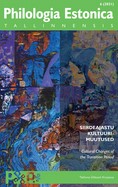Lehekoomiks 1990. aastate Eestis
Newspaper comic strips in Estonia during the 1990s
Author(s): Mari LaanisteSubject(s): Cultural history, Media studies, Visual Arts, Estonian Literature, Transformation Period (1990 - 2010)
Published by: Tallinna Ülikooli Kirjastus
Keywords: Estonian comics; newspaper comic strips; transition era; 1990s; print media; visual culture; pop culture;
Summary/Abstract: The early 1990s witnessed a rapid, broad process of transformation of visual humour in Estonian media. A large number of new print media outlets were introduced within a few years, leading to an unprecedented print media boom in the newly independent country. The new face of visual humour was shaped by the surroundings: the atmosphere of confused but enthusiastic ultra-permissiveness and uncritical openness to novelty characteristic of a freshly censorship-free society on the one hand, on the other, inevitable reflections of the post-Socialist societal and economic turmoil. The change involved a near-complete generational shift among cartoonists working for print media. The highly competitive newspapers of the era, eager to emulate Western print media standards, introduced comic strips, often resorting to commissioning original work from local authors, as imported material was more expensive. For a few brief years, Estonia developed a time- and location-specific bubble of original newspaper comics, which tended to look crude, but could also be innovative and radical, often appearing transgressive and sometimes bizarre in comparison with the standardized commercialism of internationally syndicated newspaper comic strips. With the emergence of highly popular series like „Pesakond“, comic strips quickly became one of the most notable local pop culture phenomena of the decade. The article sets out to summarize the scope of the local comic strip boom and refers to a selection of original series, including „Pesakond“ by Madis Ots; „Dr. Wunderloom“ by Hillar Mets; „Kosmose mutid“ by Alar Pikkorainen; and various series by the collective Korporatsioon Saatus and by Rainer Sarnet and Rein Pakk, to point out key characteristics.
Journal: Philologia Estonica Tallinnensis
- Issue Year: 6/2021
- Issue No: 1
- Page Range: 98-123
- Page Count: 26
- Language: Estonian

